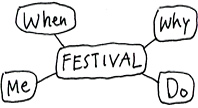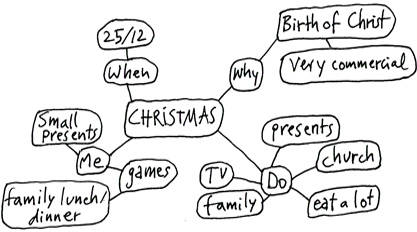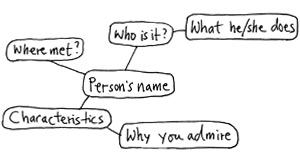A: The second part of the speaking test

In this group of exercises you will focus on the format of Part 2 of the speaking test.
1. The examiner's instructions.
What do you think the examiner's instructions will be? Mark the statements true or false.
2. The examiner's instructions.
Put the sentences in order to complete the examiner's instructions.
Watch the video again. Turn on and read the subtitles.
3. The individual long turn.
Here is the topic that the candidate in the previous exercise was given. Spend a few minutes thinking about what you might talk about if you were given this topic in an exam.
Describe a possession you couldn't live without.
| You should say: | what you use it for |
| why it is important to you | |
| where you got it from. | |
| and explain why you couldn’t live without it. | |
Now watch the video and compare your ideas with what Marina says. In the next unit you will look at planning Part 2 of the speaking test.
4. The individual long turn.
Watch the extract again and put the information in the order that you hear it. (You will not hear these sentences word for word.)
Now watch the video again. Turn on and read the subtitles.
B: Planning what you will say

In this group of exercises you will focus on planning what you will say during the individual long turn.
TIP:
As you have seen, in Part 2 of the speaking test the examiner will give you a topic and you will have a minute to prepare a short talk. It is very important that you use this minute effectively, so that when you start your talk, you can speak fluently, without having to stop and think of ideas.
A useful strategy for extending your talk is to mention the past, present and future. This will give you more to talk about and will also show the examiner that you can use different grammatical structures. For example:
(Past) I didn’t have a mobile until I was 15. All my friends had one, so I was very envious of them.
(Present) Now, of course my mobile is important to me because I use it for so many things, like …
(Future) A lot of people change their mobiles frequently, but I won’t change mine until I really need to. … etc.
1. Making notes.
In the following exercises, you will look at two approaches to planning: a linear approach with subheadings, and mind maps.
Linear notes
Look at Card 2:
Card 2
Describe a public holiday or festival in your country.
| You should say: | when the holiday is |
| what the reason/background for the holiday is (historical, religious, etc.) | |
| what people do on this day | |
| and explain why this day is special or not special to you. | |
TIP:
You need to add a few notes under each heading. Practise using abbreviations as much as possible – otherwise you will not have time to write very much at all!
Mind maps
Now look at an outline of a mind map for the same card:

And now, with some detail added:

2. Prepare for your second tutorial.
TIP:
The examiner may ask you additional, rounding-off questions to continue the discussion. Examples of rounding-off questions are given below.
Now look at Cards 3 and 4.
Card 3
Describe your experience of education.
| You should say: | where you went to school/university |
| what a class you took was like | |
| what subjects you have studied in your education | |
| and explain whether you liked school and why/why not. | |
Rounding-off questions
- Did you learn useful skills during your education?
- Did your education prepare you for work or further studies?
Card 4
Talk about a person that you admire.
| You should say: | who the person is |
| where you met this person | |
| what characteristics you most like about them | |
| and explain why you admire this person. | |
Rounding-off questions
- What did you learn from this person?
- How do you apply what you learnt in what you do?
In the tutorial at the end of this section, you will practise speaking about these topics with your tutor. For each of the topics, plan a short talk. For Topic 3, try the linear approach to note-making, and for Topic 4, try the mind map approach. While making the notes, think about which method you prefer; and during the tutorial, again, reflect on which notes gave you a more effective basis for your talk.
For each of the topics, plan a short talk. For Topic 3, try the linear approach to note-making, and for Topic 4, try the mind map approach. While making the notes, think about which method you prefer and reflect on which notes gave you a more effective basis for your talk.
Card 3
NOTES
Where? (school/university)
Kinds of schools?
Subjects?
Liked? Why?
Card 4
